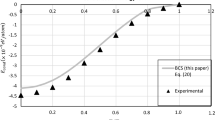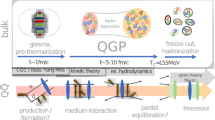Abstract
We address the importance of symmetry and symmetry breaking on linear response theories of fermionic BCS superfluids. The linear response theory of a noninteracting Fermi gas is reviewed and several consistency constraints are verified. The challenge to formulate linear response theories of BCS superfluids consistent with density and spin conservation laws comes from the presence of a broken U(1)EM symmetry associated with electromagnetism (EM) and we discuss two routes for circumventing this. The first route follows Nambu’s integral-equation approach for the EM vertex function, but this method is not specific for BCS superfluids. We focus on the second route based on a consistent-fluctuation-of-the order-parameter (CFOP) approach where the gauge transformation and the fluctuations of the order parameter are treated on equal footing. The CFOP approach allows one to explicitly verify several important constraints: The EM vertex satisfies not only a Ward identity which guarantees charge conservation but also a Q-limit Ward identity associated with the compressibility sum rule. In contrast, the spin degrees of freedom associated with another U(1) z symmetry are not affected by the Cooper-pair condensation that breaks only the U(1)EM symmetry. As a consequence the collective modes from the fluctuations of the order parameter only couple to the density response function but decouple from the spin response function, which reflects the different fates of the two U(1) symmetries in the superfluid phase. Our formulation lays the ground work for applications to more general theories of BCS-Bose Einstein Condensation (BEC) crossover both above and below T c .

Similar content being viewed by others
References
R. Kubo, M. Toda, N. Hashitsume, Statistical Physics II: Nonequilibrium Statistical Mechanics, 2nd edn. (Springer, Berlin, 2004)
A.L. Fetter, J.D. Walecka, Quantum Theory of Many-Particle Systems (Dover, New York, 2003)
G.D. Mahan, Many-Particle Physics, 3rd edn. (Kluwer Academic/Plenum, New York, 2000)
Y. Nambu, Phys. Rev. 117, 648 (1960)
L.P. Kadanoff, P.C. Martin, Phys. Rev. 124, 670 (1961)
K. Yoshimi, T. Kato, H. Maebashi, J. Phys. Soc. Jpn. 78, 104002 (2009)
K. Levin, Q.J. Chen, C.C. Chien, Y. He, Ann. Phys. 325, 233 (2010)
H. Guo, C.C. Chien, K. Levin, Phys. Rev. Lett. 105, 120401 (2010)
O. Betbeder Matibet, P. Nozieres, Ann. Phys. (NY) 51, 392 (1969)
I.O. Kulik, O. Entin-Wohlman, R. Orbach, J. Low Temp. Phys. 43, 591 (1981)
Y.Y. Zha, K. Levin, D.Z. Liu, Phys. Rev. B 51, 6602 (1995)
P.I. Arseev, S.O. Loiko, N.K. Fedorov, Phys. Usp. 49, 1 (2006)
R. Combescot, M.Y. Kagan, S. Stringari, Phys. Rev. A 74, 042717 (2006)
H. Guo, C.C. Chien, Y. He, Phys. Rev. D 85, 074025 (2012)
M. Greiter, Ann. Phys. 319, 217 (2005)
C.N. Yang, Phys. Rev. Lett. 63, 2144 (1989)
S.C. Zhang, C.N. Yang, Mod. Phys. Lett. B 4, 759 (1990)
J.R. Schrieffer, Theory of Superconductivity (Benjamin, New York, 1964)
P. Francesco, P. Mathieu, D. Senechal, Conformal Field Theory (Springer, Berlin, 1996)
A.J. Leggett, in Modern Trends in the Theory of Condensed Matter (Springer, Berlin, 1980), pp. 13–27
Q.J. Chen, J. Stajic, S.N. Tan, K. Levin, Phys. Rep. 412, 1 (2005)
H. Guo, D. Wulin, C.C. Chien, K. Levin, New J. Phys. 13, 075011 (2011)
J. Kundu, S. Reddy, Phys. Rev. C 70, 055803 (2004)
M.E. Gusakov, Phys. Rev. C 81, 025804 (2010)
Acknowledgements
We thank Prof. K. Levin for helping prepare this paper. Hao Guo thanks the support by National Natural Science Foundation of China (Grants No. 11204032) and Natural Science Foundation of Jiangsu Province, China (SBK201241926). C.C.C. acknowledges the support of the US Department of Energy through the LANL/LDRD Program.
Author information
Authors and Affiliations
Corresponding author
Appendices
Appendix A: Detailed Expressions for Response Functions
The following are the response functions for non-interacting Fermi gases:



The following are the EM response functions of BCS superfluids from the CFOP theory:










The following are spin response functions of BCS Superfluids following the same structure of the CFOP theory







Here we outline the proof of Eq. (A.17). When the index μ=0, from Eq. (106) we have

Changing variables by P→−P−Q and using the fact F(P)=F(−P), the second and fourth terms inside the bracket become G(P)F(P+Q) and G(P+Q)F(P) respectively, which cancel the first and third term inside the bracket respectively. Hence we have \(Q^{0}_{\mathrm{S}13}(\omega,\mathbf{q})=0\). Similarly, if the index μ=i, we have

Here we change variables by P→−P−Q again so the pre-factor \(\frac{\mathbf{p}+\frac{\mathbf{q}}{2}}{m}\rightarrow -\frac{\mathbf{p}+\frac{\mathbf{q}}{2}}{m}\). Hence all terms inside the bracket cancel out and we conclude that Q S13(ω,q)=0. Following the same steps, one can prove that \(Q^{\mu}_{\mathrm{S}23}(\omega,\mathbf{q})=Q^{\mu}_{\mathrm{S}31}(\omega,\mathbf{q})=Q^{\mu}_{\mathrm{S}32}(\omega,\mathbf{q})=0\).
Appendix B: Proof of the Lemma (50)
From the expression shown in Appendix A, we have

Hence

We change variables by \(\mathbf{p}\rightarrow\mathbf{p}+\frac{\mathbf{q}}{2}\) in the first term, and change variables by \(\mathbf{p}\rightarrow\mathbf{p}-\frac{\mathbf{q}}{2}\) in the second term to get

where the number equation (31) has been used. This proves the lemma.
Appendix C: Integral Equation of EM Vertex and GWI
Here we prove that the vertex determined by the integral equation (92) obeys GWI (55). We will use the following equality
To prove the proposition, we only need to show

which is equivalent to
From \(\hat{\varSigma}=\hat{G}^{-1}_{0}(P)-\hat{G}^{-1}(P)\) one concludes that
Now we turn to the proof of Eq. (C.3). By substituting Eq. (55) into its RHS and repeating the process, we get an iterative equation

After inserting the Ward identity (54) for the bare EM vertex and using Eqs. (C.4), we get

By changing the dummy index i→i+1 in the second and fourth summations, we get

where Eq. (C.1) has been applied. Therefore we have proved that any vertex that satisfies the integral equation must also satisfy the Ward identity and hence must be gauge invariant.
Appendix D: Evaluations of the Vertex
From the expressions given in Appendix A, at T=0 we have

where in the fifth line we have used p 2=2m(ξ p +μ). Note that \(\mu\simeq\epsilon_{F}=\frac{k^{2}_{F}}{2m}\). Thus
Similarly, for the temporal component of \(Q^{\mu}_{23}\) we have
Therefore \(\varPi^{0}(\omega,\mathbf{q})=\frac{\varDelta \omega}{\omega^{2}-c^{2}_{s}q^{2}}\) and the temporal component of the full vertex \(\hat{\varGamma}^{\mu}\) is given by
For the spatial component, we have

Using \(\mu\simeq \frac{k^{2}_{F}}{2m}=\frac{3m}{2}c^{2}_{s}\), we have \(\mathbf{Q}_{23}(\omega,\mathbf{q})\simeq-i\frac{N(0)c^{2}_{s}}{\varDelta }\mathbf{q}\), so
The spatial component is then given by
Appendix E: Physical Interpretation of the Gauge-Invariant Linear Response Theory
In the main text we have seen that the WIs for response functions are indeed satisfied even without knowing the exact form of the full EM vertex. Here we pay some attention to the gauge invariance of the CFOP linear response theory from the point of view of a gauge transformation for the BCS Lagrangian. In real space, the Lagrangian density following the BCS approximation is given by
where \(\hat{\gamma}^{\mu}=(\sigma_{3},-\frac{i\nabla}{m})\). This Lagrangian density is obviously not invariant under the infinitesimal gauge transformation Ψ→(1−iσ 3 χ)Ψ, Ψ †→Ψ †(1+iσ 3 χ) and A μ →A μ +∂ μ χ if the fluctuations of the order parameter are not considered. Now we split the order parameter into its equilibrium and perturbative parts as Δ→Δ+Δ′, where the equilibrium value is Δ and the perturbation is Δ′. Therefore in the CFOP theory, the Lagrangian density in real space becomes

Here the subscript “0” denotes the part in equilibrium. The gauge transformation of Ψ and Ψ † leads to the fluctuations of the order parameter δΔ 1=0 and δΔ 2=−2χΔ. Therefore, the following generalized infinitesimal gauge transformation leaves the Lagrangian density (E.1) of the CFOP theory invariant:

Under this generalized infinitesimal transformation the two parts of the Lagrangian density transform according to

Therefore \(\mathcal{L}_{\mathrm{BCS}}\) is indeed invariant under the generalized infinitesimal gauge transformation (E.3). It is the gauge transformation of Δ 2 that compensates for the effects associated with the Cooper-pair condensation and leads to the gauge invariance of the CFOP theory. The Noether current associated with this generalized gauge transformation can be deduced by introducing the “generalized gauge space”. We define the space where the generalized external potential and generalized interacting vertex (see Eq. (34)) live as the generalized gauge space. Explicitly, the perturbative Lagrangian density is rewritten as \(-\varPsi^{\dagger}\hat{\boldsymbol{\varPhi}}^{T}\cdot\hat{\boldsymbol{\varSigma}}\varPsi\), where ⋅ denotes the inner product in this generalized gauge space. The generalized gauge transformation of the generalized external potential is
We define the generalized external momentums \(\hat{\mathbf{q}}\equiv(0,2i\varDelta ,q_{\mu})^{T}\) and \(\hat{\bar{\mathbf{q}}}\equiv(0,2i\varDelta ,\allowbreak -q_{\mu})^{T}\) in the generalized gauge space. Then the generalized gauge transformation (E.5) can be written as
The GWI (44) can be expressed as
In fact, this is the generalized Ward identity associated with the generalized gauge transformation (E.5) in the generalized gauge space.
Next we address the conserved current associated with this gauge transformation. Using the self-consistent condition \(\delta J_{1,2}=-\frac{2}{g}\varDelta _{1,2}\), the current in Eq. (36) can be written as
We then define the generalized current \(\hat{\mathbf{J}}\equiv(0,0,J^{\mu})^{T}\) and three generalized response-function vectors
Then the current Eq. (E.8) becomes
The GWIs (42) for the response functions can also be written as
Thus the GWIs directly lead to the conservation of the generalized current
This gives the conservation law of the EM current q μ J μ=0. Therefore \(\hat{\mathbf{J}}\) is indeed the Neother current associated with the generalized gauge transformation. Moreover, by noting that the GWIs (E.11) in the generalized gauge space can be written as
Under the generalized gauge transformation (E.6), the generalized current transforms as
Thus the generalized current is indeed invariant under the generalized gauge transformation.
Rights and permissions
About this article
Cite this article
Guo, H., Chien, CC. & He, Y. Theories of Linear Response in BCS Superfluids and How They Meet Fundamental Constraints. J Low Temp Phys 172, 5–46 (2013). https://doi.org/10.1007/s10909-012-0853-7
Received:
Accepted:
Published:
Issue Date:
DOI: https://doi.org/10.1007/s10909-012-0853-7




